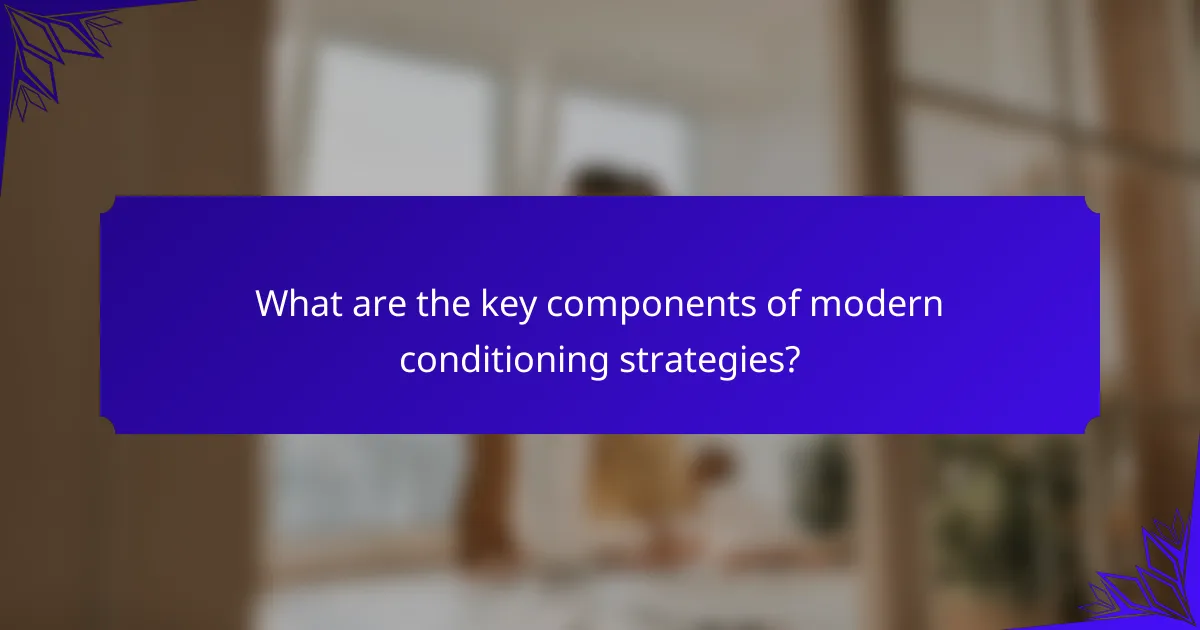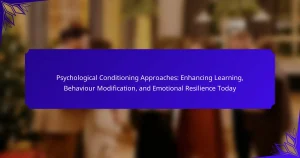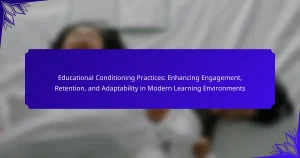Modern conditioning strategies enhance learning by integrating technology, mindfulness, and behavioral insights. This article explores adaptive learning systems for personalised education, mindfulness practices to improve focus, and behavioral insights that inform effective teaching methods. These components work together to create a more engaging and effective educational environment. Additionally, the role of personalised feedback and real-time data analytics in optimising learning experiences will be discussed.

What are the key components of modern conditioning strategies?
Modern conditioning strategies integrate technology, mindfulness, and behavioral insights to enhance learning. Key components include adaptive learning systems that personalise education, mindfulness practices that improve focus, and behavioral insights that inform effective teaching methods. These elements work together to create a more engaging and effective learning environment.
How does technology enhance learning and conditioning?
Technology enhances learning and conditioning by providing personalised experiences, immediate feedback, and access to diverse resources. These elements facilitate engagement and retention.
Modern tools like adaptive learning platforms use data to tailor content to individual needs, improving understanding and skill acquisition. Mindfulness apps integrate behavioral insights, promoting focus and emotional regulation, which are essential for effective learning.
Furthermore, virtual and augmented reality create immersive environments, allowing learners to practice skills in realistic scenarios. This hands-on approach enhances retention and application of knowledge.
Incorporating technology into learning strategies ultimately leads to more effective conditioning and improved educational outcomes.
What are the various technological tools used in modern conditioning?
Modern conditioning utilises various technological tools to enhance learning and behaviour modification. Key tools include mobile applications, virtual reality, online learning platforms, data analytics, wearable devices, and gamification techniques. These tools support personalised learning experiences, track progress, and provide real-time feedback, making modern conditioning more effective and engaging.
How do online platforms facilitate learning through conditioning?
Online platforms enhance learning through conditioning by leveraging technology to create engaging, personalised experiences. They utilise behavioral insights to reinforce desired learning outcomes and encourage consistent participation.
Modern conditioning strategies include gamification, which motivates learners through rewards and challenges. Platforms also implement adaptive learning technologies that adjust content based on user performance, optimising engagement and retention. Mindfulness practices integrated into online learning can further enhance focus and reduce anxiety, promoting a conducive environment for skill acquisition.
These approaches collectively foster a dynamic learning atmosphere that adapts to individual needs, ultimately leading to improved educational outcomes.
What role does mindfulness play in modern conditioning?
Mindfulness significantly enhances modern conditioning by improving focus, emotional regulation, and cognitive flexibility. It fosters an environment conducive to learning, enabling individuals to absorb and apply information more effectively. Research indicates that mindfulness practices can lead to a 30% increase in attention span and retention rates among learners. Integrating mindfulness into conditioning strategies not only promotes mental well-being but also enhances overall performance and adaptability in various learning contexts.
How can mindfulness practices improve learning outcomes?
Mindfulness practices significantly enhance learning outcomes by improving focus and reducing stress. They foster a conducive environment for cognitive engagement, which leads to better retention of information. Research shows that mindfulness can increase attention span and promote emotional regulation, both crucial for effective learning. Additionally, incorporating mindfulness into educational settings can lead to improved academic performance and overall well-being among students.
What techniques integrate mindfulness with behavioral insights?
Mindfulness can be integrated with behavioral insights through techniques such as mindfulness-based cognitive therapy, acceptance and commitment therapy, and mindfulness training programmes. These approaches enhance emotional regulation and promote adaptive behaviours. For example, mindfulness-based cognitive therapy combines traditional cognitive behavioural techniques with mindfulness practices, helping individuals recognise and change negative thought patterns. As a result, this integration fosters resilience and improves overall mental well-being.

What are the universal attributes of modern conditioning strategies?
Modern conditioning strategies universally enhance learning by integrating technology, mindfulness, and behavioral insights. Key attributes include adaptability, engagement, evidence-based practices, and personalised feedback. Adaptability allows strategies to meet diverse learner needs. Engagement fosters motivation and retention. Evidence-based practices ensure effectiveness through research validation. Personalised feedback supports individual progress, driving continuous improvement.
How do feedback mechanisms support learning?
Feedback mechanisms significantly enhance learning by providing timely information on performance. They foster self-awareness, encourage reflection, and guide adjustments in behaviour. Effective feedback can be immediate or delayed, depending on the learning context, and varies in form, such as verbal, written, or digital.
Incorporating technology into feedback processes has shown a unique attribute: it allows for personalised learning experiences. For example, adaptive learning platforms utilise data analytics to tailor feedback to individual needs, enhancing engagement and retention. Mindfulness practices can also amplify the effectiveness of feedback by promoting a receptive mindset, which is essential for integrating insights into future actions.
The integration of behavioral insights into feedback mechanisms further supports learning. Understanding how learners respond to feedback can inform strategies that optimise motivation and persistence. As a result, feedback becomes not just a tool for assessment but a vital component of the learning journey, driving continuous improvement and skill development.
What is the importance of consistency in conditioning?
Consistency in conditioning is crucial for effective learning and behaviour modification. It reinforces desired behaviours and enhances retention of skills over time. Regular reinforcement helps establish clear associations between stimuli and responses, leading to more reliable outcomes. This predictability fosters a stable learning environment, which is essential in modern conditioning strategies that integrate technology and mindfulness. Consistent application of techniques also allows for measurable progress, enabling adjustments based on individual responses and outcomes.

What unique attributes distinguish effective conditioning approaches?
Effective conditioning approaches are distinguished by their integration of technology, mindfulness, and behavioral insights. These unique attributes enhance engagement and adaptability in learning processes.
One significant aspect is the use of adaptive learning technologies, which personalise content delivery based on individual progress and preferences. Mindfulness practices incorporated into conditioning strategies foster emotional regulation and focus, promoting deeper learning. Additionally, behavioral insights provide understanding of motivation and reinforcement, allowing for tailored interventions that increase retention and application of knowledge.
The combination of these attributes leads to a more holistic and effective learning experience, addressing diverse learner needs and enhancing overall educational outcomes.
How does personalization enhance the conditioning experience?
Personalisation enhances the conditioning experience by tailoring strategies to individual needs. It increases engagement and motivation, leading to more effective learning outcomes. Personalised approaches leverage technology and behavioral insights to adapt content and methods, ensuring relevance and resonance with learners. This unique attribute of personalisation fosters a deeper connection, optimising the overall conditioning process.
What data is used to tailor learning experiences?
Data used to tailor learning experiences includes learner preferences, performance metrics, and behavioral insights. These elements allow for personalised content delivery and adaptive learning paths. For example, analytics from user interactions help identify strengths and areas for improvement, enhancing engagement. Additionally, mindfulness practices can be integrated to support emotional well-being, fostering a conducive learning environment.
What are the innovative assessment methods in modern conditioning?
Innovative assessment methods in modern conditioning include technology-driven evaluations, real-time feedback systems, and mindfulness-based assessments. These approaches enhance learning by providing personalised insights and fostering self-awareness. For example, adaptive learning platforms utilise data analytics to tailor assessments to individual progress, ensuring that feedback is relevant and timely. Additionally, incorporating mindfulness techniques into assessments helps learners develop emotional regulation, which is crucial for effective conditioning. This combination of technology and behavioral insights represents a unique attribute of modern assessment strategies.

What rare attributes can significantly impact conditioning outcomes?
Incorporating rare attributes can enhance conditioning outcomes significantly. One such attribute is personalised feedback, which tailors responses to individual performance, fostering deeper engagement. Another rare attribute is the integration of real-time data analytics, allowing for immediate adjustments based on learner behaviour, thus optimising the learning experience. Additionally, fostering a growth mindset through mindfulness practices can enhance resilience and adaptability, leading to improved outcomes. These attributes create a more responsive and effective conditioning environment, ultimately enhancing learning through modern strategies.
How do cultural factors influence learning and conditioning?
Cultural factors significantly influence learning and conditioning by shaping values, beliefs, and practices. These factors determine how individuals perceive information and interact with their environment. For instance, collectivist cultures may prioritise group learning and collaboration, while individualistic cultures may emphasise personal achievement. Additionally, cultural norms affect motivation and reinforcement strategies, impacting the effectiveness of modern conditioning techniques. Understanding these cultural dimensions allows educators and trainers to tailor approaches that resonate with diverse learner backgrounds, enhancing overall learning outcomes.
What emerging trends are shaping the future of conditioning?
Modern conditioning strategies are increasingly shaped by technology, mindfulness practices, and behavioral insights. These trends enhance learning efficiency and retention.
Technology integration, such as AI-driven personalised learning platforms, tailors educational experiences to individual needs. This unique attribute of adaptive learning systems allows for real-time feedback, optimising the conditioning process.
Mindfulness techniques are gaining traction in educational settings. These practices help improve focus and reduce anxiety, contributing to a more conducive learning environment. The root attribute of mental well-being plays a crucial role in effective conditioning.
Additionally, insights from behavioral science inform modern conditioning approaches. Understanding motivation and reinforcement can lead to more effective strategies. For example, gamification leverages intrinsic motivation, making learning more engaging.
These emerging trends indicate a shift towards holistic and personalised conditioning methods, ultimately enhancing learning outcomes.

How can practitioners optimise modern conditioning strategies?
Practitioners can optimise modern conditioning strategies by integrating technology, mindfulness, and behavioral insights. Utilising adaptive learning platforms enhances personalised experiences, while mindfulness practices improve focus and retention. Behavioral insights inform effective reinforcement techniques, ensuring sustained engagement and motivation.
What best practices should be followed for effective implementation?
To implement modern conditioning strategies effectively, focus on integrating technology, mindfulness, and behavioral insights. Establish clear objectives that align with learner needs, ensuring engagement through interactive tools. Foster a supportive environment that encourages mindfulness practices, enhancing focus and retention. Regularly assess and adapt strategies based on feedback and outcomes, promoting continuous improvement. Collaborate with stakeholders to ensure alignment and resource availability, maximising the impact of implemented strategies.
What common mistakes should be avoided in conditioning strategies?
To enhance conditioning strategies effectively, avoid common mistakes such as neglecting individual learner needs, over-reliance on technology without human interaction, and failing to incorporate feedback loops. These errors can hinder engagement and retention. Additionally, overlooking the importance of mindfulness can lead to superficial learning experiences. Prioritising personalised approaches and integrating behavioral insights will yield better outcomes.
How can ongoing evaluation improve conditioning methods?
Ongoing evaluation enhances conditioning methods by providing real-time feedback and insights. This continuous assessment allows for the adjustment of strategies, ensuring they remain effective and relevant. By incorporating technology, such as data analytics, practitioners can monitor progress and identify areas for improvement. Mindfulness practices also play a role, helping individuals stay engaged and aware of their conditioning journey. Ultimately, this iterative process fosters adaptive learning, leading to more successful outcomes.


